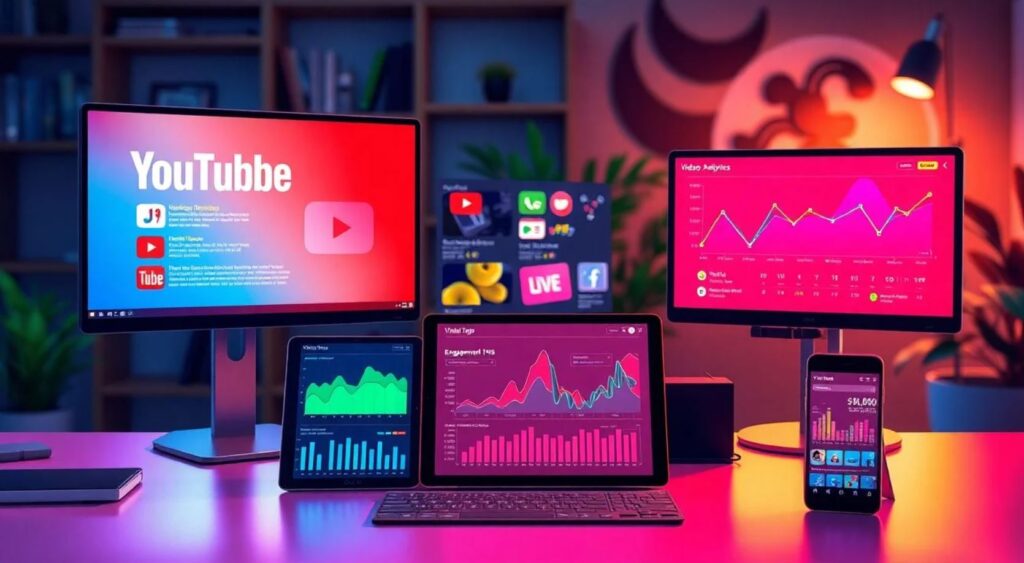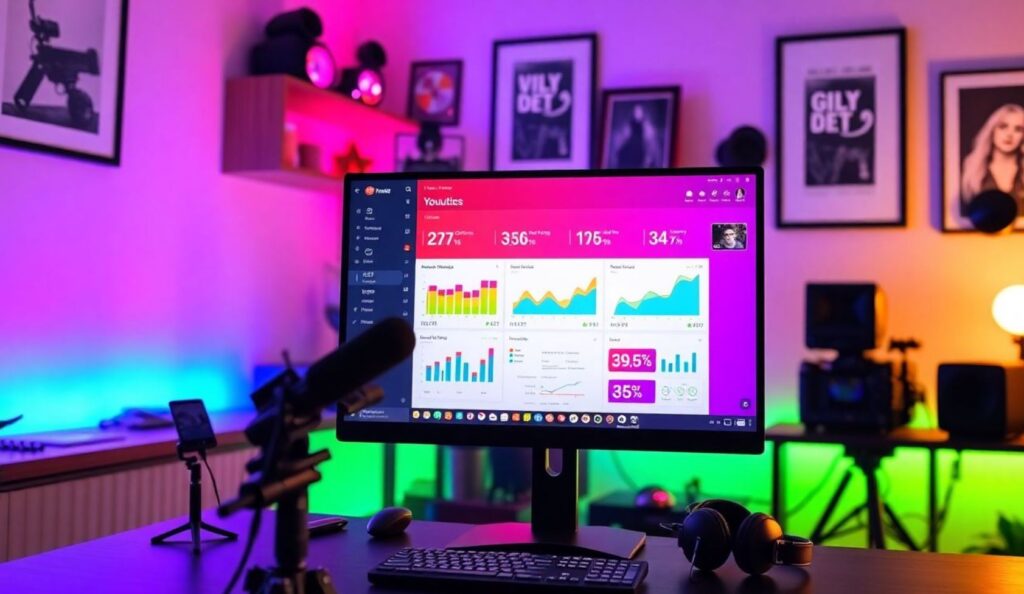Unlocking YouTube success isn’t about luck. It’s about understanding your audience. You need to fine-tune your content using data. YouTube Analytics is a goldmine of info. Ready to turn your channel into a thriving community?
This guide offers a deep look at YouTube Analytics. You’ll learn to read data and find ways to improve. You can grow your channel by using these tools. Get ready to boost your reach and engagement!
Understanding the YouTube Analytics Dashboard
The dashboard gives you a quick look at your channel’s performance. It shows key numbers like views, watch time, and subscribers. You can find this info on your YouTube Studio dashboard. Knowing where to look is the first step!
Realtime Data: What’s Happening Now?
Real-time data shows views as they happen. It highlights top videos from the last 48 hours or even the last 60 minutes. Use this info to see what’s currently hot with your audience. If a video is doing well, promote it more!
Key Metrics: Views, Watch Time, Subscribers, and Revenue (if applicable)
- Views: The number of times people watched your videos.
- Watch Time: Total time viewers spent watching your videos.
- Subscribers: People who subscribed to your channel.
- Revenue: Money earned from your videos (if you monetize).
Interpret these numbers based on your channel size and niche. A small channel might celebrate 100 views, while a larger one expects thousands.
Navigating the Different Tabs: Overview, Reach, Engagement, Audience, and Revenue
- Overview: A summary of your channel’s performance.
- Reach: Information on how viewers find your videos.
- Engagement: Data on watch time, audience retention, and interactions.
- Audience: Demographics and viewing habits of your audience.
- Revenue: (If applicable) Earnings data.
Each tab offers different insights to improve your channel.
Mastering the “Reach” Tab: Expanding Your Audience
The “Reach” tab shows impressions and clicks. It tells you where your views come from. This info helps you grow your audience.
Impressions and Click-Through Rate (CTR): The First Impression
- Impressions: How many times your thumbnails were shown to viewers.
- CTR: Percentage of people who clicked on your thumbnail after seeing it.
Improve CTR by making eye-catching thumbnails. Write titles that grab attention. A high CTR means people are interested in your content!
Traffic Sources: Where Are Your Viewers Coming From?
- Suggested Videos: Traffic from videos suggested next to or after other videos.
- Browse Features: Views from the YouTube homepage, subscription feed, and watch later.
- External Sources: Traffic from websites or apps outside of YouTube.
- YouTube Search: Viewers finding your videos through YouTube search.
Optimize for each source. Use relevant keywords for search. Create engaging content to get suggested. Share your videos on other platforms for external traffic.
Understanding Your Audience’s Search Terms
Find out which search terms bring viewers to your videos. You can see those terms in the “Reach” tab. Use these keywords in your titles and descriptions. This helps people find your videos more easily.
Decoding the “Engagement” Tab: Keeping Viewers Hooked
The “Engagement” tab focuses on watch time and audience retention. It shows how well you keep people watching. Use this info to make better content.
Watch Time: The Ultimate Goal
Watch time is super important for the YouTube algorithm. YouTube promotes videos with high watch time. To increase watch time, keep your videos engaging. Use better pacing and exciting content.
Audience Retention: Where Are Viewers Dropping Off?
The audience retention graph shows when viewers leave your video. Find the drop-off points and figure out why people are leaving. Maybe the intro is too long, or the content isn’t interesting enough. Fix these issues to improve retention.
Likes, Comments, and Shares: Measuring Interaction
Likes, comments, and shares are valuable. They show that people are enjoying your content. Ask viewers to like, comment, and share. Building a community helps your channel grow.
Analyzing the “Audience” Tab: Knowing Your Viewers
The “Audience” tab provides details about your viewers. You’ll find demographics and viewing habits here. This data helps you tailor your content to your audience.
Demographics: Age, Gender, and Location
Use demographic data to understand your audience. Tailor content to their interests. Target specific age groups, genders, or locations. If most viewers are young women in the US, create content they will love!
When Your Audience Is Online: Optimizing Upload Times
Post videos when your audience is most active. The “Audience” tab shows when they are online. This increases the chance of them seeing and watching your new videos. Upload at the right time to maximize views.
Channels Your Audience Watches: Competitor Analysis and Collaboration Opportunities
See which other channels your audience watches. This is great for competitor analysis. It can also help you find collaboration opportunities. Team up with other channels to reach new viewers.
Monetization Strategies Using YouTube Analytics (If Applicable)
If you make money on YouTube, use analytics to boost revenue. See which videos earn the most and why. This will help you create profitable content.
Revenue Per Mille (RPM) and Cost Per Mille (CPM): Understanding Ad Revenue
- RPM: Revenue per 1,000 views after YouTube’s cut.
- CPM: Cost advertisers pay for 1,000 ad impressions.
RPM and CPM depend on factors like ad type, audience, and video content. Higher RPM and CPM mean more revenue.
Top-Earning Videos: Identifying Profitable Content
Find your top-earning videos in the “Revenue” tab. Analyze what makes them successful. Replicate these strategies in future videos. Create more of what earns you the most!
Turning Insights into Action: Creating a Data-Driven Content Strategy
Use your analytics data to improve your channel. Set goals, test ideas, and give your audience what they want. A data-driven strategy leads to success.
Setting Goals and Tracking Progress
Set realistic goals based on your data. Track your progress weekly or monthly. Make changes as needed to reach your goals. For example, aim for a 10% increase in watch time each month.
A/B Testing: Optimizing Thumbnails and Titles
A/B testing helps you optimize thumbnails and titles. Test different versions to see which performs best. YouTube doesn’t have built-in A/B testing. Use tools like TubeBuddy or VidIQ.
Iterating on Content: Giving Your Audience What They Want
Use analytics to understand what your audience wants. Create videos based on their interests. If they love gaming videos, make more of them! Give the people what they want.
Also Read: YouTube Tag Showdown: 5 Creators Reveal Their Highest-Performing Tags
Conclusion: Data-Driven Success on YouTube
YouTube Analytics unlocks your channel’s potential. Understand key metrics and analyze audience behavior. Use data to drive your strategy. Focus on watch time and optimize your content. Track your progress and keep learning. You have the power to grow your channel!




